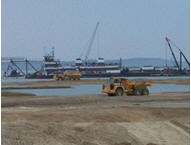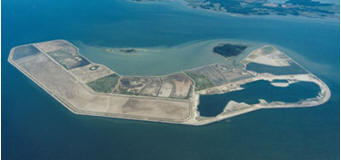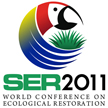OPTIONAL
Pre-Conference Technical Training Field Trip
Sunday, July 31, 2011
Poplar Island:
Paul S. Sarbanes Environmental Restoration Site
(Tour is
limited to 20 people)
Field trip seating is very limited therefore participation
is restricted to meeting attendees only. Sorry, no guests.
| Itinerary: |
|
| 7:30am
|
Bus departs Baltimore
Marriott Hotel |
| 9:30am |
Arrive at Tilghman
Island |
| 10:00am |
Boat ride to
Poplar Island |
|
10:00am-1:00pm |
Tour, lunch and
lecture on Poplar Island |
| 1:30pm |
Boat ride back to
Tilghman Island |
|
2:00pm-4:00pm |
Bus returns to Hotel |
*There is a small block of rooms
reserved for Saturday night to assist those participants
attending the Sunday tour. Please make sure to make your
hotel room as soon as possible and state that you are with
the NCER conference or the host hotel may fill.
 Poplar
Island, recently on the verge of disappearing, is today a
national model for habitat restoration and the beneficial
use of dredged material. The U.S. Army Corps of Engineers,
Baltimore District has teamed
with the Maryland Port
Administration and other Federal and State agencies
to restore Poplar Island using dredged material from the
Baltimore Harbor and Channels Federal navigation projects
(only approach channels). Just off the Chesapeake Bay
coastline, about 34 miles south of Baltimore in Talbot
County, MD, Poplar Island is being returned to its former
size and important ecological function while helping to
ensure the economic vitality of the region. Approximately 68
million cubic yards (mcy) of dredged material will be placed
to develop 735 acres of wetlands, 840 acres of uplands and
140 acres of open water embayment. Poplar
Island, recently on the verge of disappearing, is today a
national model for habitat restoration and the beneficial
use of dredged material. The U.S. Army Corps of Engineers,
Baltimore District has teamed
with the Maryland Port
Administration and other Federal and State agencies
to restore Poplar Island using dredged material from the
Baltimore Harbor and Channels Federal navigation projects
(only approach channels). Just off the Chesapeake Bay
coastline, about 34 miles south of Baltimore in Talbot
County, MD, Poplar Island is being returned to its former
size and important ecological function while helping to
ensure the economic vitality of the region. Approximately 68
million cubic yards (mcy) of dredged material will be placed
to develop 735 acres of wetlands, 840 acres of uplands and
140 acres of open water embayment.
At completion, Poplar Island will be half
upland habitat and half
wetlands. Trees, shrubs, and grasses will be planted
in the uplands and the area will support terrapins, birds
and mammals including foxes, raccoons, squirrels and deer.
The wetlands will be a combination of low marshes and high
marshes. Low marshes are wetland habitats that are regularly
flooded by tidal waters. High marshes are infrequently
flooded due to strong winds or exceptionally high tides. The
wetlands will be planted with a variety of plants to provide
habitat for a wide range of animals including, fish, shrimp,
crabs, shorebirds, wading birds, and mammals.

Detailed Tour Information (Printable PDF)
|


 Poplar
Island, recently on the verge of disappearing, is today a
national model for habitat restoration and the beneficial
use of dredged material. The U.S. Army Corps of Engineers,
Baltimore District has teamed
Poplar
Island, recently on the verge of disappearing, is today a
national model for habitat restoration and the beneficial
use of dredged material. The U.S. Army Corps of Engineers,
Baltimore District has teamed
